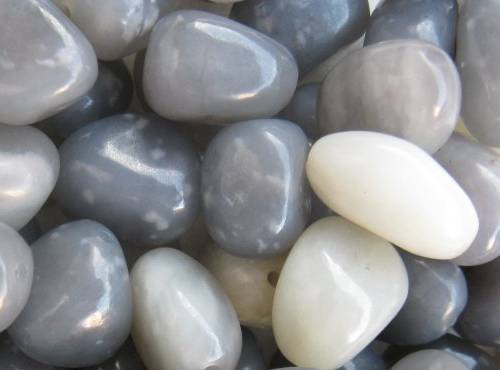The main features of Kunlun jade
2019-02-25 01:11:02
 Since the Olympic Medals were inlaid, Kunlun jade has become a household name from little-known people. In particular, Kunlun jade and Xinjiang Hetian jade are in the same metallogenic belt, and because Xinjiang Hetian jade resources reserves are very scarce, in recent years, Kunlun jade in Qinghai has occupied the domestic market. A larger share. In order to let jade enthusiasts know more about Kunlun jade, invited experts to write and analyze the characteristics of Kunlun jade.
Since the Olympic Medals were inlaid, Kunlun jade has become a household name from little-known people. In particular, Kunlun jade and Xinjiang Hetian jade are in the same metallogenic belt, and because Xinjiang Hetian jade resources reserves are very scarce, in recent years, Kunlun jade in Qinghai has occupied the domestic market. A larger share. In order to let jade enthusiasts know more about Kunlun jade, invited experts to write and analyze the characteristics of Kunlun jade. In accordance with internationally accepted scientific methods for the determination of Kunlun jade in Golmud, Qinghai Province, its main features are as follows:
(i) Petrological characteristics. Qinghai Kunlun jade is a kind of single-mineral jade composed of microcrystal tremolite aggregates. The content of jade tremolite is mostly more than 99%, and there is very little impurity minerals. It is the same as Xinjiang Hetian jade's X-ray powder diffraction measurement data.
(b) Crystallographic features. There are four main structures of Kunlun jade in Qinghai: 1. Crystallized structure of microscopic leaves; 2. Microfibrillar crystal structure (commonly known as felt-like structure); 3. Microfibrillar, bundled crystal structure; 4. Analytical Residual structure. Its structure is dominated by blocks, and some jade pieces are plate-like, sheet-like, and layered structures.
(c) Ingredient characteristics. Chemically determined, the chemical composition of Qinghai Kunlun jade and Xinjiang Hetian jade is basically the same. The main ingredient is silicate, which is a mineral formed by the contact between magnesium marble and medium-acid magmatic rocks, and has a big difference from serpentine jade.
(d) Physical characteristics. The refractive index of Qinghai Kunlun jade is 1.60 to 1.62, with an average of about 1.61; the measured density is 2.95 to 2.99 g/m2; the hardness is equivalent to Mohs 5.6 to 6.0.
(5) Unique characteristics of "stone flower" and "waterline". Through slicing studies, the “stone flowerâ€, “stone brainâ€, and floccus aconite in the Kunlun Mountains of Qinghai Province are mainly caused by minerals such as coarse-grained tremolite, dolomite, and quartz; the “waterline†and “water dew "It is caused by the parallel arrangement of tremolite fiber crystals distributed in strips, veins and clumps. This feature from the negative point of view, is the shortcomings of Kunlun jade (and Hetian jade ratio); and from the front, it is the advantages of Kunlun jade, is a sign of its authentic identity.
(six) raw material characteristics. Mainly mountain material (mineral material), rare earth material (leather material), occasionally saw material. This situation is related to the natural environment where the raw materials are located. The Kunlun Mountains in Qinghai Province are produced on the hills in the shallow hilly areas of the surrounding grasslands and lack sufficient rivers. The raw materials were exfoliated and weathered in situ, and there was no condition that the river was transported and rubbed over long distances. However, during the construction of the Qinghai-Tibet Railway, when the workers of the China Railway Fifth Bureau dug the foundations of the Sanchahe Bridge, they found large seed jade, with a diameter of more than 30 kg and 100 kg. The blocks had smoke, white, and green colors, like landscape paintings. same. It shows that there were rivers in the jade-producing areas in ancient times, and they had the conditions for transporting seeds and jade.
(7) Appearance characteristics. Qinghai Kunlun jade mainly has the following varieties: white jade, grayish-wax white, less "sugar white". Translucent, most of the transparency is significantly greater than the Hetian white jade, it is lack of sense of dignity, the lack of Hetian jade's moist feeling; Qingbaiyu, light grayish green, grayish gray or light yellow gray, fine texture uniform, Shuitouzu, more welcomed by the industry; Qingyu, Qing Shi - dark grayish green, darker in hue, but the water is full, oily, and often better than Hetian Qingyu; smoke Qingyu, grayish purple, smoke gray, etc., which is commonly known as violet, silk lotus, black cyan It is unique to Qinghai nephrite, and it is highly valued; green jade, light green, often attached to white jade, green and white jade raw materials, forming a block or a sandwich, especially pure jade on the basis of pure jade is precious, It is the most popular jade species in Qinghai nephrite; sugar jade, mainly light brown, because its color is too heavy or too light and has a greater impact on the perception of jade, the use of lower value; jasper, dark green or black, The delicate texture, pure color, and high degree of lubrication have been promising for the domestic market in recent years.
Through the above analysis, it can be affirmed that although there is a certain distance between the Qinghai-Kunming jade and Xinjiang Hetian jade, there is a close relationship between the Hetian jade and the end of the Xinjiang Hetian jade and Ruoqiang, etc. on the geological structure background. They are located in the Kunlun Mountains and the Altun Mountains, and are formed by the contact between magnesium marble and medium-acid magmatic rocks. According to the method of measuring the gemstones of the world, the jade produced in Qinghai Kunlun Jade is the same as the jade produced by Hemo and Ruojiao. It has the meaning of completely matching the name of Chinese nephrite and is a very rare jade resource.
Note Pad Holder,Memo Pad Holder,Memo Pad
Jewelry Box Co., Ltd. , http://www.nscardholder.com